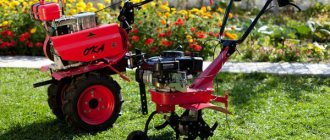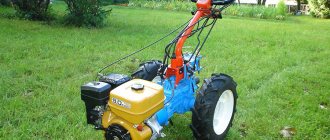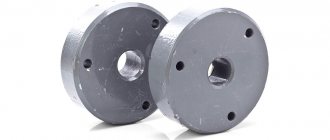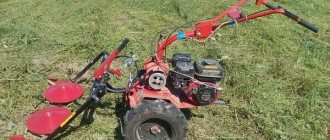Soviet walk-behind tractors are old, but quite reliable equipment for vegetable gardens and gardens, which can be used for various purposes. Such motor cultivators are indispensable not only for weeding the land, but also for transporting goods. Today, many walk-behind tractors of different models are produced.
But most domestic cultivators are made on the basis of old Soviet models, which have proven themselves over a long time.
Features of Soviet walk-behind tractors
Soviet walk-behind tractors are old, but quite reliable equipment for vegetable gardens and gardens, which can be used for various purposes. Such motor cultivators are indispensable not only for weeding the land, but also for transporting goods. Today, many walk-behind tractors of different models are produced.
But most domestic cultivators are made on the basis of old Soviet models, which have proven themselves over a long time.
founded in 1988. At the beginning of her journey, she manufactured attachments for mini-equipment from third-party brands. But in 2007, the first walk-behind tractor, MKM-3, was developed and released, which immediately became in demand among Russian farmers.
Mobile K MKM-3
The line of MKM-3 walk-behind tractors consists of three models that differ in engines. For example, the Comfort model is equipped with a Dinking DK170F engine with a power of 7 hp. With. The unit is suitable for work in a summer cottage where the soil is periodically cultivated. The machine was created according to the GOST R ISO 11449-99 standard. Milling cutters are installed instead of wheels; cultivation width up to 73 cm. It is also possible to connect equipment using a pulley.
Advantages:
- manufactured according to GOST;
- large selection of attachments.
Flaws:
- little weight.
Average price - 45,000 ₽
The history of the appearance of walk-behind tractors
In ancient times, it was very difficult for people to cultivate the land. Especially when it came to large areas. The hoe and plow were actively used. But such tools could not work automatically. It was necessary to harness cattle or horses to plow a plot of land. Sometimes people even harnessed themselves if there was no cattle at home. All this took a lot of effort and time.
But in 1911, Maenburg invented the electric motor cultivator. This was a real breakthrough. Since that time, this invention has been constantly improved, supplemented with new useful devices and mechanisms. As a result, the rotary motor cultivators known to everyone today appeared, and then tractors. And since 1937, the production of motor cultivators has become widespread. It has become much easier for people to tidy up their gardens.
When the Soviet Union was born, the production of motor cultivators was not so active. The authorities did not see the point in this, since most of the land was the property of collective farms, and not private individuals. And on collective farms, vegetable gardens were plowed using tractors. Closer to 1970, the mass production of walk-behind tractors in the USSR began to improve.
After the collapse of the Soviet Union, the production of motor cultivators did not stop. On the contrary, the production of such mechanisms has become more active. After all, people’s need for additional equipment for cultivating land has increased several times.
The structure of the Soviet walk-behind tractor
What is an old-style walk-behind tractor?
As a rule, compared to a modern cultivator, this mechanism is simple. But at the same time, it is reliable, since in the old days only the highest quality materials were used for the production of equipment, and the assembly was carried out in good faith. The transmission of all such old walk-behind tractors is worm-gear. This is the simplest option, but it is the one that is very reliable. In general, it is customary to divide all old-style walk-behind tractors into motor cultivators and wheeled implements. There are some differences between them both in appearance and in the principle of operation.
In a motorized cultivator, the tool for plowing the soil is mounted directly on the drive axle. Due to this, the work is carried out. With a wheeled motor cultivator, weeding occurs due to the traction force, so working with such a device will be somewhat difficult for a physically weak person.
But even old-style wheeled walk-behind tractors mostly run on gasoline engines. Soviet-style mechanisms have two-stroke engines. But modern walk-behind tractors are already made with four strokes. This ensures more efficient and faster tillage. But old models of such equipment are still taken as a basis.
Some models of Soviet walk-behind tractors were already equipped with rotation regulators. These are special mechanisms that allow the gardener to control the unit in semi-automatic mode. But most machines were designed for mechanical work only. There was no talk of any automation in the USSR.
The main difference between a cultivator and a walk-behind tractor
The cultivator is intended for mechanical tillage of the soil before sowing. This device evenly cultivates the soil without turning over the soil plates.
The walk-behind tractor carefully loosens the top layers of fertile soil, quickly gets rid of weeds and evenly distributes fertilizer around the entire perimeter. It is widely used for processing greenhouses, greenhouses and beds.
Improving Soviet walk-behind tractors to current models
Nowadays there are many varieties of modern walk-behind tractors produced. Such mechanisms greatly facilitate the agricultural work of gardeners and make it possible to save a lot of time and effort. But absolutely all modern domestic walk-behind tractors are produced on the basis of the old model, borrowed from the times of the USSR.
How are modern devices fundamentally different from Soviet ones, if they are produced according to almost the same principle? The fact is that most models managed to improve during this time.
The main criterion is the presence of a semi-automatic or fully automated control system. Most Soviet walk-behind tractors did not have such a system. Modern mechanisms are all equipped with such a system to ensure high-quality weeding of the earth.
Most often, special steering rods are installed in walk-behind tractors, with their help the operator exercises control. Walking on the ground, a person controls the mechanism only with the help of light hand movements. Therefore, it is not necessary to apply force here. Most often, the controls for the walk-behind tractor clutch are located on the left rod, and the gas handle, which helps control the engine, is on the right rod.
Motoblock "Luch" MB-1: technical characteristics
Motoblock “originally from the USSR”
Motoblocks of old brands, developed and produced in the 80s, which include Luch MB-1, are distinguished by the simplicity of their design and the elementary nature of all engineering solutions. This, of course, very far from ideal, light agricultural equipment was still made of very strong and high-quality steel. And it is characterized by amazing reliability and durability (which cannot be said about most modern walk-behind tractors). "Luch MB-1" is a device on which you can cultivate your garden almost all your life. With proper care, the number of breakdowns and repairs is reduced to a minimum.
Popular Russian brands
Russian farmers choose brands that are time-tested, for example, the Belarusian MTZ - the equipment of this company occupies almost 80% of the market for all agricultural equipment in Russia. But today we’ll talk about brands that are manufactured at Russian factories - these are the brands KADVI, Neva, Agat and others.
The equipment is produced in the workshops of Soviet factories, which were converted for the production of civilian goods. For example, at the plant named after. Degtyarev in the city of Kovrov in the Vladimir region produces walk-behind tractors under the Favorit brand. But the main capacity of the plant is aimed at fulfilling government defense orders.
About the manufacturer and history of the Luch MB-1 model
The Luch MB-1 walk-behind tractor is in the same line with several other modifications of such equipment, which differ only in names, but are very similar both in appearance and in the design of all parts and assemblies. And the factory index for all is the same - “MB-1” (there is also an absolutely identical version, differing only in the shape of the fuel tank - “MB-5040”).
The names for their products were chosen by manufacturing enterprises, many of which belonged to the military-industrial complex and the aviation industry. The manufacturer of the Luch MB-1 walk-behind tractor was the Perm Production Association Motorostroitel named after Sverdlov (now JSC UEC Perm Motors), a manufacturer of aircraft engines.
The eighties and nineties of the twentieth century became for this plant the time when its products “came down from heaven to earth.” The line of manufactured equipment has been replenished with new models of gas turbine equipment intended for operation as part of gas pumping units of compressor stations of main gas pipelines and gas turbine power plants.
And also, in the light of the general “fashion for conversion” - consumer goods, among which, since 1985, was the Luch MB-1. In previous years, there was no point in producing walk-behind tractors in the Soviet Union: there was no market demand for them. Personal gardens were plowed and cultivated with collective farm tractors, either free of charge or for a reasonable fee. There was always a lot of gasoline and diesel fuel in farms, and they cost mere pennies. The years of destruction of the previous agricultural system throughout the country - the second half of the 80s and all of the 90s - became the time for the spread of the production and use of domestic walk-behind tractors.
Main products.
Currently (more precisely, since the beginning of the 2000s), Luch walk-behind tractors and other non-core “small” equipment have been removed from the lists of products manufactured by the Perm plant: it again produces only turbojet aircraft engines and industrial gas turbine mechanisms. This is also a nationwide trend: the production of walk-behind tractors has been abandoned everywhere at similar enterprises.
However, many of the Luch MB-1 walk-behind tractors sold back in the last century are not only in working condition, but also work season after season without serious breakdowns; pass from hand to hand and are considered a familiar assistant in the households of families from different regions of Russia and the CIS. Not every mechanism is able to demonstrate such durability in use.
JSC "KO-Neva"
The St. Petersburg manufacturer of agricultural equipment Neva is a subsidiary of the St. Petersburg aircraft manufacturer OJSC Red October. Motoblocks have been produced since 1985 as a consumer product. The equipment is certified according to international standards, and more than 150 companies provide service.
Neva MB-2 KS
Farmers use the Neva MB-2 KS walk-behind tractor. This machine is equipped with a Kasei KS168FA power unit with 6.5 liters. With. To move forward, the equipment is equipped with four speeds. The car weighs 85 kg.
The unit is used for plowing land, mowing grass, and removing snow. Paired milling cutters, which are mounted instead of wheels, are responsible for milling the soil. When working with a plow, instead of transport wheels, lugs are installed, which increase traction with the ground. The active linkage takes power from the belt drive.
Advantages:
- reliable engine;
- adjustable steering wheel.
Flaws:
- the axle shafts do not turn off.
Average price — 46,950 ₽
Brief description of the walk-behind tractor, its purpose and scope of application
The Luch MB-1 walk-behind tractor is a compact, relatively lightweight unit for cultivating soil in personal plots and vegetable gardens, as well as for some other agricultural work. It is as simple as possible in design and quite convenient to use. Maintenance and repair are also not something complicated, requiring special knowledge or training. All you need to do is read the instruction manual. And spare parts are available and inexpensive.
The compatibility of the walk-behind tractor with additional attachments is good, but when using them with the MB-1, of course, you must carefully follow the instructions contained in the operating manual for each attachment. A powerful and economical four-stroke engine allows you to use the walk-behind tractor in various household works.
What capabilities does the walk-behind tractor have?
When buying a walk-behind tractor for a personal plot, many begin to use it to cultivate the land. Not every amateur gardener is familiar with its mechanical capabilities.
Many additional functions allow you to perform a wide variety of types of work. Most often this is:
- plowing;
- landing;
- hilling;
- excavation;
- grass cutting;
- winter work;
- transportation and transportation of goods.
Plowing is carried out using a special plow, which is fixed at the bottom of the device. It helps to plow deeper layers of soil, while mixing them together and gently cultivating them.
As a result of this, the soil is enriched with oxygen, which increases its fertility. In 2-3 plowings, the uncultivated surface turns into a full-fledged plot of land.
Hilling is carried out using a hiller attachment. It allows you to evenly process rows of potatoes. Thanks to it, the upper layers of the soil are saturated with oxygen. The plant begins to bear fruit quickly.
Planting and disembarking is carried out using an unusual nozzle in which the planting material is placed. It is planted to the required depth.
The harvest is excavated using a flat plow. The walk-behind tractor carefully moves along the row spacing, thereby lifting the top layers of soil along with the contents of the bushes. Modern models have special limiters that prevent damage to the crop.
Lawn care includes a rotary head that cuts the grass to the desired height. Some configurations come with a special aerator. It allows you to enrich the soil with oxygen. As a result of this, vegetation begins to grow quickly and intensively. The lawn turns out dense and bright green.
Winter work is carried out with a snow shovel, which is fixed on the outer part of the equipment. Snow masses are evenly distributed on both sides of the path.
Design of the Luch MB-1 walk-behind tractor
Structurally, this walk-behind tractor consists of the following main parts: engine; clutch mechanism; gearbox; handles with controls; two tire wheels (or four cultivators). Details about the engine are given below. the clutch mechanism is designed to transmit the energy of the crankshaft torque from the engine to the gearbox and consists of two belts; forward pulley; reverse pulley; drive pulley; gear pulley, rods; forward and reverse levers, and springs.
The gearbox is designed to change the gear ratio and transfer rotational energy from the gearbox pulley to the wheels and working equipment. The chain reducer consists of two halves of the housing; chains; shift shaft; shift knobs; three blocks of sprockets and an output shaft.
The controls located on the handles are used to change the operating modes of the engine and the direction of movement of the walk-behind tractor. They consist of: the steering wheel itself; motor control lever; gear shift knobs. The steering wheel is attached with four bolts to the gearbox angles, and it is equipped with height adjustment.
The engine control lever is attached to the right handlebar with a screw, which is connected to the throttle valve of the regulator by a cable through a lever and a spring. On the left handle of the steering wheel, on top, there is a forward lever, which is connected to the forward pulley through a rod, chain and spring. And below, on the same left handle, there is a reverse lever, which is connected through a chain, rod and spring to the lever on which the reverse pulley is installed. The transmission provides operation in 2 forward and 2 reverse gears.
The wheels on the Luch MB-1 walk-behind tractors are either pneumatic or cast rubber, size 4.00×10″. The outer part of the tread is most often made in the form of a traditional herringbone, and when installing such wheels on a walk-behind tractor, they must be placed with the corners forward. And to get the best results when plowing, hilling and digging up root crops, it makes sense to replace rubber wheels with metal ones with lugs. Instead of wheels, a cultivator can be installed on the output shaft of the gearbox.
JSC GMZ "Agat"
In 1968, JSC Gavrilov-Yamsky Machine-Building Plant was founded, which produces parts for aircraft engines. The production of motorized equipment Agat began in 2002 as a consumer product. At first, the equipment was produced to order from other companies, but later they developed their own walk-behind tractor, which was already released under the Agat brand.
Agate L6.5
The Agat L6.5 model is equipped with a Chinese Lifan 168f2 engine, the same engine is installed on the Oka and Ugra walk-behind tractors. Structurally, the machine is designed so that the center of gravity of the unit is shifted forward. As with other gasoline walk-behind tractors weighing up to 100 kg, cutters are installed instead of wheels. It is possible to install four or six cutters, with six sections of cutters the cultivation width reaches 80 cm. In addition to milling, the unit performs hilling, mowing and snow removal work.
Advantages:
- large cultivation width;
- stable design.
Flaws:
- a light weight.
Average price - 31,000 ₽
Walk-behind tractor engine; transmission and chassis
The walk-behind tractor is equipped with a DM-1 engine. This is a four-stroke, single-cylinder, air-cooled carburetor gasoline engine with a displacement of 316 cubic centimeters and a power of 3.7 kW (5 horsepower). Piston diameter – 76 mm; piston stroke – 70 mm. Engine lubrication system - splash and in the oil sump; ignition system – contactless, electronic, with spark plug “A17B” (AII-I GOST 2043-75).
Starting is carried out by a built-in manual starter. The direction of rotation of the crankshaft is counterclockwise (view from the crankshaft pulley). The permissible engine tilt angle is no more than eight degrees.
The arrow indicates the screw for adjusting the fuel supply to the carburetor of the Luch MB-1 walk-behind tractor.
Modern Chinese analogues of the MB-1 are equipped with Lifan, Lianlong, Vanguard, and Briggs and Stratton engines. And also the CADVI 168F-2A motor (Kaluga Engine), which is produced in Kaluga from foreign components and is similar in its technical characteristics to DM-1. In general, for its time, “DM-1” was a very progressive engine option for compact agricultural machinery. Many walk-behind tractors of those years were equipped not with four-stroke, but with two-stroke engines.
"Tool Academy"
The company was founded in Perm in 1997, its specialization is the production of special equipment for working in gardens and parks. "Academy of Tools" produces walk-behind tractors under the Tselina brand. The units are equipped with power plants from the Chinese manufacturer Lifan.
Tselina MB-901R
The Tselina MB-901R walk-behind tractor is similar in characteristics to the machine from MTZ, but in design it is closer to other gasoline units. A Lifan petrol engine with a power of 9 hp is mounted on the frame. With. The attachment can be mounted instead of wheels, for example a cutter, or can be hung on the frame of a walk-behind tractor, for example a snow blower. The unit is suitable not only for summer cottages, but also for small farms.
Advantages:
- reliable design;
- powerful engine.
Flaws:
- no trailer hitch.
Cost - from 32,000 ₽
Technical specifications in numbers
- The weight of the walk-behind tractor is 100 kg.
- Travel speed is from 3.6 to 9 km/h.
- Overall dimensions: length – 1.5 m; width – 60 cm; height – 1.15 m.
- Ground clearance – 140 mm.
- Working track width – 570 mm; transport gauge – 310 mm;
- The minimum turning radius is 1.1 m.
- Traction force – not less than 100 kgf.
- The working width of the equipment cultivator is adjustable, from 725 to 1200 mm; diameter – 360 mm.
- Average fuel consumption is from 1.5 to 2 liters of gasoline per hour.
- The volume of the fuel tank is 3.6 liters of fuel.
Reviews from owners of Luch MB-1 walk-behind tractors
Reviews from direct users of the Soviet walk-behind tractor are, for the most part, purely positive. People are especially impressed by its reliability, unpretentiousness, and durability in use. However, this equipment requires proper care.
Nothing supernatural: monitor the oil level and do not operate the walk-behind tractor if the oil level in the engine and gearbox is less than required; do not practice prolonged work at maximum speed and with maximum load; Do not press the forward and reverse levers at the same time; do not change gears while the walk-behind tractor is moving, and the like.
In terms of work comfort, the Luch MB-1 walk-behind tractor, like all similar agricultural machines of its generation, is, of course, very far from ideal. For example, some owners over time changed the muffler to a quieter one - a fair amount of noise during operation is really quite annoying and annoying.
There is positive experience in using the Luch MB-1 walk-behind tractor as a snow blower, hay mower, cargo transporter on a trolley, and even a drive mechanism for a hole-digging drill; feed crushers.
Application
For a cottage or village for cultivating a plot of land
In order to decide which is best to buy a walk-behind tractor for a summer residence, you must first decide exactly what amount of work it should do and how long it should take. Since a dacha, in most cases, is a place for seasonal work, and not a permanent place of residence, an appropriate walk-behind tractor is needed.
a lightweight walk-behind tractor with a power of about 3-4 horsepower and a weight of about 70 kilograms is perfect Equipment such as walk-behind tractors Husqvarna, Carver, Texas, Cayman are convenient, primarily due to their size - they can be placed anywhere, because they do not take up much space.
Easy
The fuel consumption of a light walk-behind tractor is very low, regardless of the load. The amount of necessary attachments for such equipment is minimal, since such walk-behind tractors are not designed for working with heavy soils and deep tillage.
But they are perfect for use as a snow blower or drive for a threshing machine - if necessary, it can be connected to these devices using a gearbox and belt drive.
The power that the engine develops is quite enough to grind grain and even root crops, and due to low fuel consumption, such a drive is not much more expensive than an electric motor.
Also, the country option may not be the most expensive product , since its use does not imply heavy loads or regular use every day.
Thus, the engine resource will be used up gradually, and peak operation will occur only a few times a year, during cultivation of the site before sowing the crop and after harvesting it.
Powerful motor plow for home and garden cultivation
As for the question of which is better to buy a walk-behind tractor for your home, the situation here is a little different. For a household, using a walk-behind tractor becomes the main task. Work that can be done with it appears almost every day. Here we can recommend the Plowman, Luch, Niva, Salyut walk-behind tractor.
Therefore, it can be difficult to get by with only a light walk-behind tractor - the need to transport goods, cultivate a large plot of land and other, not so important functions require a long engine life, power and weight. In addition, the size of the device is also important here - the width of its grip.
Medium walk-behind tractors have an average power of 4-5 horsepower and a working width of 80 centimeters.
Average
Such characteristics allow you to process a plot of 20-30 acres in a fairly short time without any problems or loss of time. Also, a walk-behind tractor with such characteristics can be supplemented with a trailer without much difficulty.
Its carrying capacity will be sufficient to deliver bulk cargo and cargo weighing up to 500 kilograms over long distances, albeit at a low but stable speed.
Also, medium walk-behind tractors are equipped with a large number of attachments, which makes them more versatile than light walk-behind tractors.
In addition, after being heavier, they are able to perform work comparable to heavy walk-behind tractors, albeit with less productivity.
Although the design of medium walk-behind tractors is usually not too complicated , especially from domestic manufacturers, their service life is not much longer than that of light walk-behind tractors, since very often the engines are modifications of “weaker” models.
Although this is also a kind of plus - their parts fit together perfectly, sometimes not even differing much in price.
How to choose a reliable one for virgin lands
The answer to the question “which walk-behind tractor is better for virgin soil?” unambiguous - only a heavy walk-behind tractor. The two previous types of walk-behind tractors are simply not able to cope with the scope of work that arises when cultivating virgin lands.
Heavy walk-behind tractors usually weigh about 150 kilograms and have a power of 10 horsepower, although there are models that have both higher and lower power.
This technique is capable of processing almost any soil, no matter how heavy and sticky it is. These include motoboks Patriot, Foreman, Crosser, Viking, Forza, Sadko, Don, Huter, Profi, Champion, Lifan. In addition, the working width of heavy walk-behind tractors can be greater than 90 centimeters, which allows you to quickly cultivate large areas of land - up to one hectare, in a short time.
Such walk-behind tractors are most often used as cargo transport , since they can be used to transport large loads without overloading the engine.
Also, they are perfect for modification into a mini tractor - thanks to the large size of the body and a convenient control system, which can be easily converted from levers into a steering wheel, and the powerful engine easily drives the additional axle without losing productivity.
Heavy
As for attachments, such models are equipped with almost everything necessary for carrying out field work of any type and in any conditions. In addition, all the missing parts and components can be made for them, for example, lugs.
These are metal wheels with special blades that allow the walk-behind tractor to “lift” compacted, very dry soil without stopping or unnecessary maneuvering. At the same time, all the work is done only by the engine and weight, without the need to tow the walk-behind tractor.
The drive life of heavy walk-behind tractors is also much longer than that of less powerful types, since due to the high cost of this equipment, only reliable materials with great strength and wear resistance are used for its manufacture.











